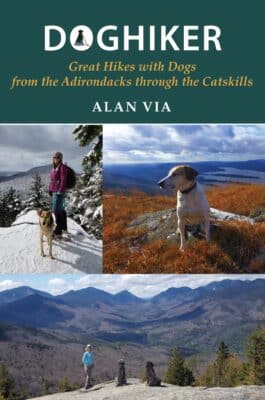Disclosure: This content may contain affiliate links. Read my disclosure policy.
First a quick Thank You! to first rate dog moms Diana @NatureAddictLady and Kara @JJnMe33 for their valuable additions below — and a second Thanks! to Diana for letting me use her awesome portrait of Roxy.
Elevated Risks
From springtime on, temperatures and humidity can spike, but June, July & August bring heat indices that regularly shoot past safe limits for our canine companions.
Mountain hikes are much harder than regular walking is on all of us. We factor in elevation gain because we know it slows us down. And, of course, our hikes are usually measured in hours rather than minutes.
All of this presents an elevated risk for dogs.
Dogs are exceptionally determined beings — you might say they’re dogged — so they just chug along, steadfast and unwavering, until they drop. I’ve seen dogs get exhausted on the trail just lie down, looking completely beat.
The situation can get out of hand very quickly, and it can be difficult to turn a case of heat stroke around. Some municipalities have taken to banning dogs from hiking trails when the temperature gets above safe limits.
First Assessment
The very first thing to assess is your pupper’s overall ability to hike hard on a hot/humid day.
Long-haired dogs, short-legged dogs, and short-nosed dogs are all susceptible to heat stroke long before most people realize.
- Long hair traps heat close to the body
- Very short-haired dogs can get sunburned
- Short legs keep dogs much closer to baking hot earth and rocks
- Short noses and snouts make breathing difficult
Get access to hyper-detailed trail guides, insider tips, and expert advice. Join a vibrant community of like-minded hikers, receive exclusive content, and embark on unforgettable outdoor adventures. Whether you’re a seasoned outdoor enthusiast or just starting out on your hiking journey, this website provides invaluable resources to help you explore the best trails in the Catskills, Adirondacks, Hudson Highlands, Berkshires, and beyond. Get access now to all content on this website instantly and enjoy unique supporter benefits.
Other questions to quickly review…
- Is your dog too young or too old for the hike you have planned?
- Is your dog overweight?
- Is your dog used to this much exercise?
- Are all your dog’s vaccinations up-to-date?
- Does your dog have any health issues that need to be factored into your planning?
- Is your dog obedient, leashed, and under control at all times?
- How will your dog react to a bear, a snake, or a porcupine?
Can You Self Rescue Your Dog?
Could you carry your dog back out if you had to? Often, you’ll be miles from a trailhead and hours from your car.
If your dog gets exhausted or injured, how much does he or she weigh? Good luck carrying an additional 60lbs on top of your 15-20lb backpack.
BTW, you might also enjoy…
- NEW › New York Hike Finder Tool
- CATSKILLS › Escarpment Trail Guide
- STAY › Find Your Perfect Catskills Stay
- ADIRONDACKS › Dix Range from Elk Lake
- ENTERTAINMENT › 15 Best & Worst Hiking Movies
- Follow › My Instagram @TotalCatskills
- Follow › My Substack @TotalCatskills
- Follow › My writing for Times Union
Heat Indexes & Heat Stroke
A heat index is the temperature the body feels when heat and humidity are combined. This very clear Heat Index Chart advises caution for dogs when the heat index rises above 75°F (24°C). Which is not that hot!
- When the heat index reaches yellow/caution, dogs should be outside for no more than 20 minutes (even with shade and water)
- When the heat index reaches light orange/extreme caution, dogs should be outside for no more than 10 minutes
- Heat indexes above these levels are not safe for dogs at all
Signs of Heatstroke
Heatstroke occurs regularly in dogs. Fatalities are common. Common symptoms include…
- Heavy panting / rapid breathing
- Difficulty breathing
- Loss of coordination
- Rapid pulse
- Excessive drooling
- Vomiting / diarrhea
- Lethargy
- Seizures
- Unconsciousness
As a rule of thumb, when it’s over 85° it may be best to keep your dog inside.
If your dog develops any of these symptoms it’s crucial to get your bestie cooled down with water and breezes (natural or artificial). Move into the shade, keep ears, paws and head wet. But do not over-cool your dog.
This page has more specific advice on what to do if your dog has heatstroke.
Less Than Heatstroke is Still Very Sucky
Don’t be oblivious. Keep an eye for signs your dog is simply tired or struggling. Some dogs will dig in dirt or wet leaves to try and cool off.
Water Sources May Be Dry
You can’t count on mapped water sources being available. I recently hiked up Wittenberg from Phoenicia and the spring marked on maps was bone dry.
Your dog will need extra water to drink, and lots of extra water to help cool off. Unless you’re absolutely sure safe water will be available on the trail, you’ll need to carry all that extra water.
Tip: as the temperature rises, make sure to keep heads and ears nice and wet.
Water Sources May Be Contaminated
Giardia & Cryptosporidium
Giardia is highly infective. As few as ten Giardia cysts produced infection in a clinical study of male volunteers. The incubation period ranges from 3 to 25 days. The main symptom is chronic diarrhea. Not fun. Read the EPA Giardia Fact Sheet.
Personally, I wouldn’t let my dog drink from a natural water source, not until the water has been filtered or treated. You should treat all water sources in the Catskills and Adirondacks as likely vectors for Giardia and Crypto.
It may be impossible to prevent your dog from lapping water on a long hike, so there is a risk attached to being around any natural water source.
Harmful Algal Blooms (HABs)
The DEC has a great page on HABs here and there’s also an interactive map that shows current and archived HABs.
Without specialized knowledge it’s too hard to tell a HAB from a non-harmful algal bloom. Common sense says it’s best to avoid swimming in, or drinking from, any water where you spot a bloom.
Additional Kit to Pack
Best Gear for Your Best Pal
A light, collapsible water bowl is a great addition to your kit.
Rather than using your regular neck collar, think about switching to a harness, especially if your dog has a tendency to pull. You don’t want additional stress on your dog’s neck when he’s already struggling to breathe and sweat through his mouth.
You can also Google “cooling collar for dogs” to get info on this basic soak-and-wrap technique.
If you’re hiking later in the day, think about a set of booties for those four paws. (Try walking outside in bare feet in July or August, you’ll see what I mean.)
For first aid, Vet Wrap is great, but also some basic gauze and bandages. Pack a tick twister, tweezers and some Benadryl.
An excellent new resource for dog moms and dads is Alan Via’s new book Doghiker — a comprehensive guidebook for hiking dog owners that includes 77 great hikes in the Adirondacks and Catskills. If you don’t want to feed the Amazon beast, here’s a link to my bookshop.com list of hiking books which is a great way to support local bookstores.
Alan has his own ideas about warm weather hiking which he shared with me. He writes…
“In springtime, when there is no tree canopy, I look for trails under conifers or that follow streams, or have other bodies of water. I stay away from trails that are out in the open or above tree line when it’s hot, and remind people that dogs have non-removeable fur coats. Carry enough water and train your pooch to drink from a hydration hose. Hikers need to remember that the hydration of their canine companions comes first.”
Finally, think about a soft muzzle. If your dog is protective or nervous and you get injured, you can save others from your best friend’s protective instincts.
Additional Food
You won’t just need extra water. For anything more than a few miles, pack whatever you’d normally feed your dog during the day, plus an additional 25%-30% to account for the extra effort.
Good Advice
Start Small, Build on Basics
If you haven’t hiked much with your pup, make sure to break him in slowly. This helps in terms of fitness, but also in getting his paws used to and ready for the trail.
Don’t jump suddenly from leisurely neighborhood walks to 3-9 hour mountain hikes, especially if your dog has been living la vida lazy or is overweight.
Avoid Overexertion / Monitor Breathing
Trails are exciting places for dogs. I often think hiker dogs have the best doggie lives. However, especially in the heat and humidity, their excitement can lead to overexertion very quickly.
Monitor breathing, take frequent breaks, and watch how quickly your dog bounces back.
If your dog shows any kind of stress, stop and reassess your day.
Hike Early
One way to beat the heat is to start early. Really early. If you can, start before dawn. This has three benefits…
- After hours of darkness, the ambient temperature is much lower;
- The soil and rocks have also had a lot of time to cool off, and have not yet been subjected to the sun’s rays;
- It takes hours for the worst of the day’s heat to build up.
Hike in the Shade
Ask around for intel on shadier hikes. I hiked Cross Mountain recently and it was a well-screened route almost the whole way, with a lot of thick deciduous woodland to shield me from the sun.
Many Catskills hikes are like this, as none of our summits are above the tree line. But some trails have exposed stretches and sun traps where the heat can really build up.
You, Too!
Finally, don’t forget to take care of you! Your dog is at risk if you succumb to a heat-related illness. Make sure you pack enough extra cooling strategies and supplies to get back safely.
One trick I like on extra hot days, or extra long hikes, is packing a small bottle of Gatorade that’s been frozen solid. It thaws out as the hike progresses and means I have something during the hottest part of the hike. And those extra electrolytes are a big help right when I need them.
Further Reading
- Alan Via’s new book Doghiker
- https://www.backpacker.com/skills/the-manual-take-your-dog-hiking
- https://bearfoottheory.com/how-to-keep-dogs-cool-in-summer/
- https://thebark.com/content/dangers-dogs-hiking-heat
- https://www.rei.com/learn/expert-advice/hiking-dogs.html
- https://www.rover.com/blog/dog-heat-stroke/
- https://www.rover.com/blog/how-to-enjoy-hot-weather-hiking-with-dogs/
Read More
Get instant access to the full version of this site and enjoy great supporter benefits: full galleries, full trail notes, early access to the latest content, and more.
Follow my @TotalCatskills content on Instagram for regular hiking inspo and safe, inclusive community.
Get full access…
Hot on the website right now…
Follow for more…




Thank you for this information! We always carry a backpack dog carrier. If one of our dogs is injured or ill, we can put them in the backpack carrier (can be worn on either your back or chest) and carry them out that way. We also have all the other pet safety gear, along with plenty of water.
Alan Via’s book looks fantastic – I will check it out.
That’s a great suggestion. Thank you! Alan’s book may be out of print right now. I think I saw it for sale (used) on Amazon the other day for $167!!!
It’s available at a reasonable price on bookshop.org: https://bookshop.org/books/doghiker-great-hikes-with-dogs-from-the-adirondacks-through-the-catskills/9781438478388
(Also, consider Bookshop.org over Amazon.com whenever you’re buying a book — doing so supports local bookstores, see more at https://bookshop.org/pages/about)
Great tip, thank you!